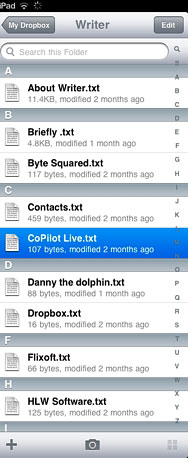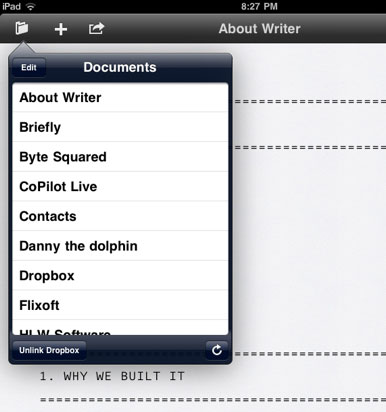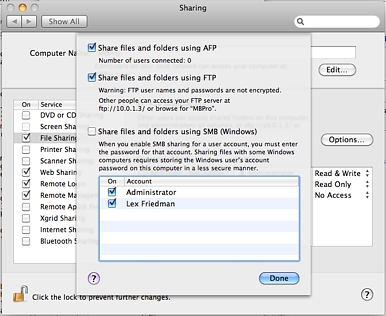Transfer files from, to iPad devices
TipsMake.com - An obvious fact is that you can use the iPad instead of a Mac to complete many common computing tasks. However, unless you completely replace the Mac computer, you still have to transfer the file back and forth between the iPad and the computer if you want to finish the job.
However, transferring and synchronizing files between this computer and tablet device is not easy at all. There are several ways to do this, but none is perfect because they all have their own shortcomings. Honestly, this is an area where Apple can upgrade its iPad experience. Until this happens, here are some options users can think of when wanting to transfer files between devices.
iTunes
Apple's official file transfer path between iPad and Mac is via iTunes. However, this is an extremely slow process.
First, it only works with applications that support it. All Apple iPad creation tools - Pages, Keynote, Numbers, GarageBand, and iMovie - use iTunes to transfer files. Some third-party applications such as e-readers, text-reading applications and multimedia creation tools also use this method.
However, different applications use iTunes in different ways. For example, Apple applications require users to select Save to iTunes when saving a data; Other applications will automatically create files available with iTunes.
Even worse, though, it always requires files to be synchronized. So far, you may have understood the procedure: Connect your iPad directly to your Mac computer and open iTunes. Select the iPad in iTunes' source list and click on the Apps tab. Browse through the list of installed applications and search for File Sharing. Select the application you want to copy the file and its files will appear in the Documents panel. Drag one or more files in it to the Desktop (still holding the Option key) to copy them there, or use the Save To button to open a common save window. If you've just updated a file on your Mac and want to send it to the iPad, you'll have to drag this file back to itunes, get the correct data list of the application you want to copy the file to.
Hard to be easier
We have yet to see a solution - AppleScript, Automator workflow, a 3rd party application - can help make this process easier. Therefore, we use iTunes' large file sharing as an extra backup for Pages and GarageBand projects. However, what about small files? Requires working on a single file from both Mac and iPad computers of the workflow is really too inconvenient to use often.
Cloud storage
When thinking about file synchronization, Dropbox instantly appears in our heads. This service does a good job of keeping files synced between computers. So, what can it do for the purpose of syncing files between Mac and iPad computers?

The Dropbox for iPad app provides access to synced files, but there's no way to save the edits you've made on tablet devices.
Even so, Dropbox on iPad is simply not appropriate. The Dropbox application, as well as other cloud storage services (including MobileMe iDisk), provides an easy way to access any files and folders you have saved on this service. Dropbox's application has a few advantages when it allows to display any data stored in iOS 'friendly' format, including Word and Pages data, PDF, text files and image files. More amazing, Dropbox and other services offer the option to open synced files with iPad-compatible applications. For example, users can use the Dropbox application to send a Word data to Pages.
The drawback to this process is that there is no way to send the updated file back to Dropbox from Pages. Due to limitations in the current way iOS works, cloud storage applications are 'one-way streets' on the iPad. It simply takes files from Dropbox into an application, but users can't send them back to Dropbox when they're done.
There is another solution. For applications that support WebDAV - such as Pages - users can use DropDAV (free 2GB of storage) to access the Dropbox folder. DropDAV allows you to communicate with Dropbox files via WebDAV connection. Because Pages allows you to open files from a remote WebDAV server, users can receive data and edit it on a tablet device. Just remember that you are working with a local copy. Once you've finished editing, you need to upload the data back to the WebDAV server. This is really the easiest way to meet the Dropbox Mac experience on the iPad, but it's still not really smooth.
Applications compatible with the cloud
There are a number of iPad applications that have built-in support for cloud storage (most commonly Dropbox). In fact, Dropbox's website lists more than 130 applications that integrate with this service.
There are many Dropbox-compatible iPad text editing applications, including Elements () ($ 5), iA Writer () ($ 1), and Textastic ($ 10). With these applications, synchronization is much simpler; Your changes will be saved directly to Dropbox; Changes made on Mac computers will be updated almost immediately on iPad. Users also do not need to connect the iPad to a Mac computer.

Some iPad text editing applications, such as iA Writer, allow you to save files directly to Dropbox.
Besides text editing applications, the list of word processing applications that are compatible with Dropbox is as much. We can include such as DocumentsToGo () ($ 17), QuickOffice () ($ 15), and Office2 () ($ 6); file reader applications like ReaddleDocs () ($ 5) and GoodReader () ($ 5); Audio notes application like DropVox ($ 1), Audio Memos ($ 1), Mobile Recorder ($ 1), and Smart Recorder ($ 3), along with many other applications. When the application allows you to open and save data directly from and to Dropbox, managing new files is easier.
Apple's iPad app doesn't integrate with Dropbox, but they work with MobileMe iDisk. However, the integration between them is not as smooth as the Dropbox apps. Uploading to iDisk is like iTunes file sharing; You are copying the file to a remote server instead of maintaining a single version, always synchronized.
However, Apple's iWork suite is lacking in quality synchronization, which tends to create ways for you to synchronize: Besides iDisk, users can share iWork data via iWork page. .com, send them to iTunes or copy via WebDAV. However, none of these options catch up to the simplicity that our Dropbox apps have used above. The new DropDAV service mentioned above may help, but lacks all the sophistication that a Dropbox integration really provides.
Unless and only if Apple and other vendors work together to somehow synchronize 2-way, otherwise the next great thing will be email.
Of course, email cannot synchronize near real time than iTunes file sharing, but you can still send copies of data files. However, make sure you always work with the latest version. Still, email still gives you some unique benefits compared to the way iTunes does.
First, you don't have to connect your iPad to a Mac computer. Next, the email includes the date stamp, so you won't have to guess whether you're working with the latest version of a file; Users can see exactly when it is sent.
If you plan on relying on email to transfer a lot of files, it is necessary to create special rules in the email application for choosing to own these special messages. For example, in Gmail create a filter to search for messages sent from and to yourself, and messages containing attachments. These messages receive a Files tag and are stored. In this way, the Mail on iPad application will display them neatly into a folder with the same name as the file.
FTP
FTP file transfer protocols are another option when you want to transfer files from and to iPad devices. There are many FTP applications in the App Store for iPad, including FTP On The Go Pro ($ 7), FTP Deluxe HD ($ 1), and FTP Write ($ 5). These applications allow users to connect to an FTP server and then edit the files stored there.

If the Mac computer is shared via FTP, users can send files from and to iPad devices using an FTP application.
If you have access to a remote FTP server (via a web hosting company or by other means), both Mac and iPad computers can connect to it. However, this means you will have to download files to your Mac every time you want to work with them. Instead, users can choose to configure the Mac computer as an FTP server. To do this, go to the Sharing system preference and make sure that File Sharing is turned on. Then, click the Options button and create a check mark in Share Files and Folders Using FTP . Next, System Preferences will tell you the FTP address of the Mac computer. Note that, unless the server has a static IP address and a standard configured router, this will be a bit difficult (if not impossible) to connect a Mac computer as an FTP server when the iPad is not in common. wireless network.
Using FTP from an iPad can help, because it ensures that you can work with just one copy of a file at any time. However, if you cannot receive files while online outside your home, this is really a serious problem.
The iPad is a USB drive
There are many applications - including iFlashDrive ($ 2), and Briefcase ($ 5) - that allow the use of an iPad as a USB drive. Therefore, users can transfer files from and to iPad devices. These applications often connect to Mac computers (if users turn on File-sharing) over local Wi-Fi networks; Someone can also connect using Bluetooth. Some even support remote access - including the ability to connect to SFTP servers.
However, this process is no different from iTunes File Sharing: Users can copy files, but need to manage the process manually.
Identify:
The sad truth is that managing iPad files is a chore. Users can feel this truth in two ways: real-time synchronization when using one of the Dropbox-linked text editing applications for iPad. However, the synchronization solutions that other applications provide really cause trouble with the iPad device itself. Until Apple offers a better solution, we still rely on Dropbox text editing applications when possible, and use email to move files.
You should read it
- How to add the cloud icon to the Windows 10 right-click menu
- Things to know when storing data on 'cloud'
- File transfer between iPad and Mac
- Data synchronization between platforms and devices
- 10 tips to keep cloud storage safe and secure
- How to Connect a Device to iTunes
- The best 'cloud storage' data storage services today
- Dropbox and Box.net: Compare free versions
May be interested
- Play WMV files on iOS devices
 it's great to own an ios device like iphone or ipad. these devices do a lot of things that might surprise you at first. however, there are also some things that are not done by themselves or done well.
it's great to own an ios device like iphone or ipad. these devices do a lot of things that might surprise you at first. however, there are also some things that are not done by themselves or done well. - How to simply copy files from computer to iPhone / iPad
 when copying data from computer to iphone device (not jailbreak) via itunes tool, we can only apply to image and video files, and other files like doc, xls, and pdf are not. today, we will share with you two small applications, called documents and playerxtreme media player, in which documents can help you freely copy all different file types to iphone, playerxtreme media player help transfer media files from computer to iphone without plugging in the cord or itunes.
when copying data from computer to iphone device (not jailbreak) via itunes tool, we can only apply to image and video files, and other files like doc, xls, and pdf are not. today, we will share with you two small applications, called documents and playerxtreme media player, in which documents can help you freely copy all different file types to iphone, playerxtreme media player help transfer media files from computer to iphone without plugging in the cord or itunes. - 6 apps to 'airdrop' files between Android and iPhone
 when it comes to sharing files between devices, apple users have airdrop available, but what if you want to transfer data between android and ios devices?
when it comes to sharing files between devices, apple users have airdrop available, but what if you want to transfer data between android and ios devices? - How to Put AVI Files on iPhone or iPad
 this wikihow teaches you how to transfer avi video files to an iphone or ipad. apple ios doesn't natively support the avi format, but you can use a third-party app like vlc to sync and watch these videos on mobile. alternatively, you can...
this wikihow teaches you how to transfer avi video files to an iphone or ipad. apple ios doesn't natively support the avi format, but you can use a third-party app like vlc to sync and watch these videos on mobile. alternatively, you can... - Ways to transfer data between phone and computer without connecting cable
 you need to transfer the file but forget to bring the cable between the phone and the computer? are you afraid of encountering a virus if you transfer files through physical devices? please apply one of 5 ways below to transfer data safely and quickly.
you need to transfer the file but forget to bring the cable between the phone and the computer? are you afraid of encountering a virus if you transfer files through physical devices? please apply one of 5 ways below to transfer data safely and quickly. - How to use Dropbox Transfer to send files online
 dropbox transfer shares files and data via shared links with up to 100mb of file upload.
dropbox transfer shares files and data via shared links with up to 100mb of file upload. - How to transfer photos from iPhone, iPad to Windows 10 computer?
 suppose if your iphone's memory capacity is full and you want to transfer pictures from iphone to windows computer. if you are an expert in ios devices, you can easily do it. but if it is a new user, unfamiliar with the features of ios, it is indeed very difficult.
suppose if your iphone's memory capacity is full and you want to transfer pictures from iphone to windows computer. if you are an expert in ios devices, you can easily do it. but if it is a new user, unfamiliar with the features of ios, it is indeed very difficult. - 10 great ways to experience the iPad
 did you know you can transfer movies on your pc to your ipad, use your ipad as a second computer monitor, connect to external speakers and keyboard via usb port?
did you know you can transfer movies on your pc to your ipad, use your ipad as a second computer monitor, connect to external speakers and keyboard via usb port? - How to transfer files to / from Linux servers using SFTP
 if the openssh daemon is running on that computer, users can connect to it via secure / ssh ftp (sftp) protocol.
if the openssh daemon is running on that computer, users can connect to it via secure / ssh ftp (sftp) protocol. - No software needed, this is the fastest way to transfer images between iOS and Mac devices
 there are many ways to transfer photos or screenshots on ios devices to mac. for example, you can send these images to email, sync via dropbox, use a usb cable to connect mac to iphone, or use image capture application or share via airdrop.
there are many ways to transfer photos or screenshots on ios devices to mac. for example, you can send these images to email, sync via dropbox, use a usb cable to connect mac to iphone, or use image capture application or share via airdrop.










 Yahoo Messenger for iPad is available in iTunes Store of iTunes
Yahoo Messenger for iPad is available in iTunes Store of iTunes Cisco ASA 5585-X - The most powerful security device available today
Cisco ASA 5585-X - The most powerful security device available today Who really invented the personal computer?
Who really invented the personal computer? Overclock CPU, GPU and RAM easily and safely
Overclock CPU, GPU and RAM easily and safely These free utilities check and diagnose hard drive health
These free utilities check and diagnose hard drive health The remarkable processors ever
The remarkable processors ever